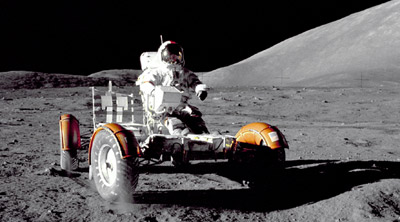 Apollo 17 Lunar Roving Vehicle being driven by Eugene Cernan
Apollo 17 Lunar Roving Vehicle being driven by Eugene Cernan
Watch this animated video to discover how the Moon's orbit means we always see its best side.
The animated video linked to above implies that the Moon’s axial spin stays exactly in step with its orbit round the Earth. This is not quite true. Although the Moon does spin exactly once per orbit, its orbital speed varies around its not-quite-circular (elliptical) track.
When furthest away it travels slowest. The spin gets slightly ahead then, but lags behind when the Moon is closest and so moving faster. This animation shows how this makes the Moon appear to wobble. This wobble, or ‘libration’, means that with patience you can eventually see about 59 per cent of the lunar surface.
The Moon’s state of synchronous rotation has been brought about by tidal drag between the Earth and the Moon. The same process has brought almost all the moons of the other planets into synchronous rotation too. When a planet has several moons, tidal interactions tend to bring their orbits into synch too. For example, in the time it takes Jupiter’s largest moon, Ganymede, to orbit once, the next moon in, Europa, orbits exactly twice and the next one, Io, orbits exactly four times.
It’s 40 years since the last Apollo Moon landing. To remind yourself what the lunar surface looks like, try these panoramas.
Did you know that the Science and Technology Facilities Council has samples of moon rocks that are available for educational loan, such as to schools and astronomical societies? You can find out more via the Science & Technology Facilities Council.



Rate and Review
Rate this article
Review this article
Log into OpenLearn to leave reviews and join in the conversation.
Article reviews